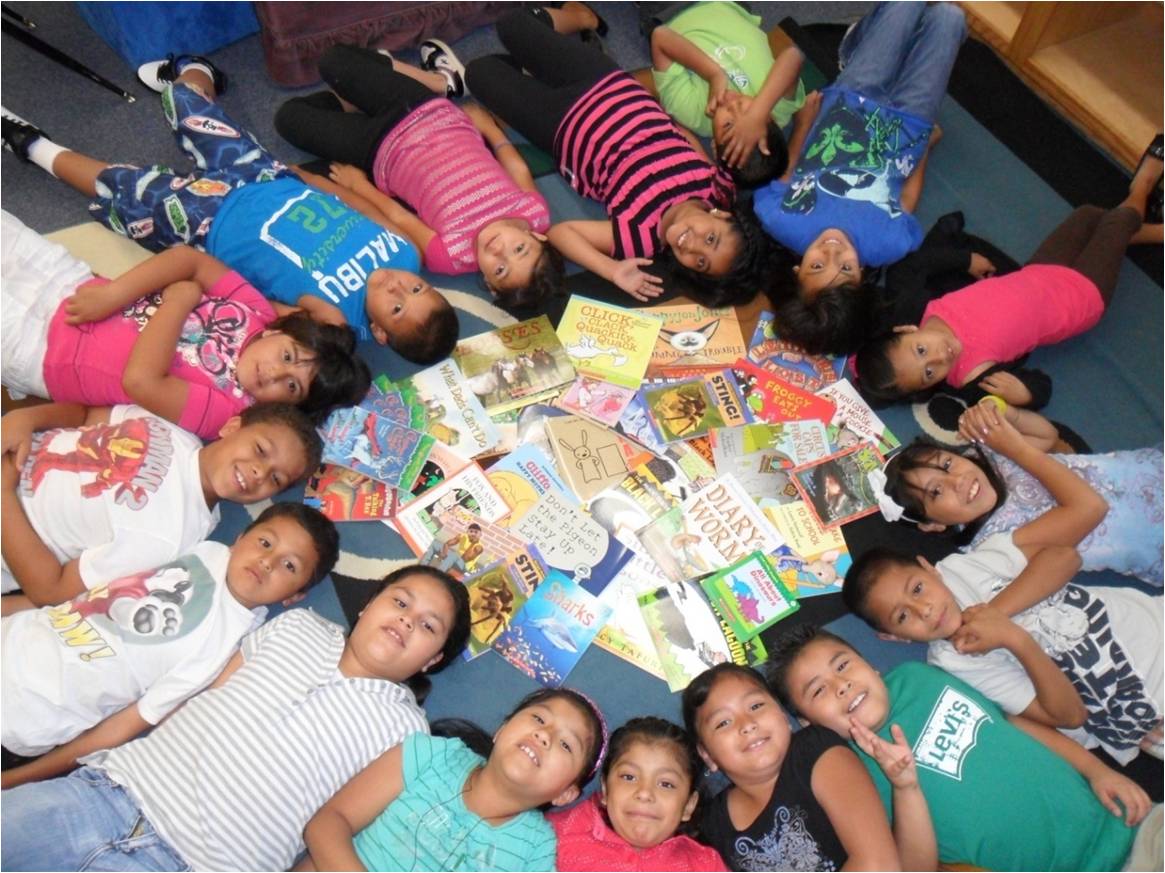This year Jones Elementary students will continue learning ALL summer long. Announcements were made, notes were sent home, and parent meetings were held to make all families aware of summer reading activities at school and even in the community. The most important thing for students to do over the summer is READ! Throughout the school year the students were given 25 books through The Home Library Project. To continue this reading momentum, students received reading logs to document their reading progress over the summer.
Jones Elementary is a school site for the district summer lunch program. All students under 18 can eat lunch for free Monday-Friday at the school throughout the summer. Having students in the building for lunch was an opportunity we could not pass up to encourage summer learning. A book swap is held each Wednesday before they begin serving summer lunch. During this time, students bring back any book they have finished and swap it for a new book.
An additional way to encourage summer reading is a book fair. In a few weeks, students will bring their reading log to school and be given "reading bucks" based on how many books/days/minutes they have read over the summer. Students will be able to purchase new books with the "reading bucks" they have earned.
Another exciting incentive to read will take place in August. The local fire department will be coming to do a fire hose spray event. Students will use their reading log as a ticket to enter the event. Students will be able to run through water and enjoy popsicles together.
Families were also informed about how to sign up for programs at the Springdale Public Library over the summer. Registration forms were distributed for the students and sent over to the library once completed.
Exciting times are in store for Jones' readers of all ages. Doesn't this excitement make you want to begin reading???
Posted by Justin Minkel on Sunday, 04/26/2015
Last week I wrote a column for Education Week on the damage done by a “D” grade awarded to our high-achieving, high-poverty public school:
My editor responded to the first draft with a simple question:
“Has the grade affected students at all? You say that such policies have a punitive impact on high-poverty students but you don't really spell out why.”
His question baffled me, because I thought I had spelled out the impact on students. It took a re-reading of my draft to realize he was right.
An effective teacher, by definition, focuses on the needs of students. We meet their needs all day in myriad ways. Sending books home with them at night. Figuring out their interests, strengths, and needs, then teaching in a way that honors those individual elements. Conveying to each child her potential and the hard work it takes to fulfill it.
We need to add another job to that list.
When advocating for policies to better meet student needs, we can’t bury our lead: the students. We need to explain how the changes we advocate will improve learning outcomes for students, not just working conditions for teachers.
LEADING WITH THE IMPACT ON STUDENTS
Most teacher leaders have spent years thinking about the connections between the larger system and individual children. As a result, connections that may be evident to us are not always clear to policymakers or members of the public.
We sometimes stumble by making the same oversight I made when writing the first draft of that column.
We focus first on the impact felt by teachers from a bad policy, assuming our audience will make the logical leap to the impact on students. We can’t make that assumption.
Example: Consider my school’s “D,” awarded based on a new state formula that pays scant attention to growth. The following argument will gain little traction with non-teachers:
This failing grade hurts teacher morale.
You can imagine the responses:
- “Who cares? Do a better job and your morale will go up.”
- “You know what hurts student morale? Not learning how to read and do math.”
- Or, in the immortal monosyllable uttered by Dick Cheney in response to data that most Americans opposed the Iraq war, “So?”
The three arguments below are much more likely to move policymakers, legislators, and the public at large to improve the formula that branded our school with a failing grade.
1. For children living in poverty to succeed in school, life, and a career, they need highly effective teachers and principals. Systems that fail to measure growth often drive talented teachers and administrators away from high-poverty schools.
I know plenty of teachers, principals, and superintendents who are willing to work harder on behalf of high-poverty kids with daunting obstacles to their learning. But when these educators are publicly labeled as failures—even if they elicit greater growth than schools with more affluent populations—it creates a reverse incentive. These teachers and leaders may decide to move to a school or district with a population that requires less growth to reach proficiency.
In the case of my own school, we have the great fortune of being led by a superintendent, principal, and teachers who care too much about their students and are too deeply rooted in their community to leave. But talented educators considering their next career move might think twice about going to a school where harder work for greater growth still results in a failing grade.
2. When you publicly shame a school, you send an implicit message to students and families that they have failed, too. This stigma has potent consequences for communities already confronted with poverty and racism.
True, some schools and districts are failing their high-poverty students. They are not eliciting the growth you should be able to expect from a child despite obstacles like poverty or learning English as a second language.
Lack of growth in a truly failing school is not the kids’ fault. There’s nothing wrong with the children; there is something wrong with the system providing them a second-class education.
But many high-poverty schools throughout the nation have received failing grades due not to poor instruction, but to poverty. To be clear, children living in poverty—including English Learners—are capable of brilliance, remarkable growth, and the same levels of academic achievement as more affluent students. But for a child who enters our school several years below grade-level, it may take more than a single year for that child to catch up—even if she makes more than a year’s growth.
When students at schools like mine receive a schoolwide failing grade despite outperforming students at more affluent schools, they receive the message that they are failures.
When my 1st graders take the MAP test, I emphasize their individual growth goals rather than their overall score. If I didn’t do that, kids far below grade-level could make 20 points of growth and still look like failures, while students above grade-level could make no growth and still look like successes. The same principle applies to grading growth rather than overall attainment for schools.
3. Over-emphasizing a single test leads to increased time spent on test prep. This narrow focus eliminates many of the rich experiences that contribute most to student learning, like science experiments, engineering projects, and time devoted to the arts.
Some people disagree with this point. They insist that if you simply provide rich, rigorous classroom instruction, test scores will rise. But for children who live in poverty and speak English as their second language, it takes an enormous amount of time to teach the vocabulary, format, and strategy involved in standardized tests. Most of this skill set has limited application to any endeavor other than taking tests.
When a school’s public perception is based on a single standardized test, teachers and principals will spend more time preparing students for that test. The result is a narrowing of the curriculum.
The very system declared as an antidote to poor instruction for high-poverty students ends up damaging those students’ access to rigorous instruction. It robs them of opportunities to develop creativity, critical thinking, ingenuity, and other 21st century and non-cognitive skills—which tend to have a far greater impact on success in college, career, and life than accurately filling in bubbles on a multiple choice test.
Children living in poverty need the arts and sciences just as much as more affluent students. Their chances of attending and graduating college depend on that access.
More immediately, they deserve an education that ignites their imaginations. The saying that “a child is a candle to be lit, not a cup to be filled,” applies to all children—not just those in middle-class zip codes.
CONNECTING THE DOTS
Education policy impacts too many students’ lives to leave it entirely to non-teachers. For those of us who choose to teach and advocate for better policies, we have to keep one critical point in mind:
What we understand intuitively about the connections between our profession and student learning is not always apparent to people outside the classroom.
Professional autonomy, a role in shaping policy, and collaboration time in the school day all have an undeniable connection to better outcomes for students. But if we don’t connect those dots for people who haven’t lived the connections, it will sound like we’re just trying to make things better for ourselves, not for the students in our care.
When teaching a new concept to our students, we meet them where they are. We don’t assume they already know what we know.
We need to do the same thing with policymakers, legislators, and members of the public. It’s the only way to bring about the changes we know our students need.













